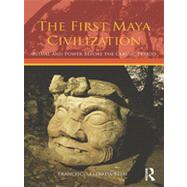
The First Maya Civilization: Ritual and Power Before the Classic Period
by Estrada-belli; Francisco-

Free Shipping On Orders Over $35
Your order must be $35 or more to qualify for free economy shipping. Marketplace items, eBooks and apparel do not qualify towards the $35 purchase minimum.
-
 eCampus.com Device Compatibility Matrix
eCampus.com Device Compatibility Matrix
Click the device icon to install or view instructions
Buy New
Rent Textbook
Rent Digital
Used Textbook
We're Sorry
Sold Out
How Marketplace Works:
- This item is offered by an independent seller and not shipped from our warehouse
- Item details like edition and cover design may differ from our description; see seller's comments before ordering.
- Sellers much confirm and ship within two business days; otherwise, the order will be cancelled and refunded.
- Marketplace purchases cannot be returned to eCampus.com. Contact the seller directly for inquiries; if no response within two days, contact customer service.
- Additional shipping costs apply to Marketplace purchases. Review shipping costs at checkout.
Summary
Author Biography
Table of Contents
| List of figures | p. ix |
| Preface | p. xii |
| Acknowledgements | p. xv |
| Maya civilization in perspective | p. 1 |
| An overview of Classic Maya research | p. 4 |
| Classic Maya people, places and history | p. 9 |
| The beginnings of Maya civilization | p. 28 |
| Trajectories of evolution: Maya archaeology and the Preclassic Maya | p. 31 |
| Theories of the origins of Maya civilization: the first part of the 20th century | p. 31 |
| Theories of the origins of Maya civilization: the second part of the 20th century | p. 33 |
| Peasant pioneers | p. 36 |
| The earliest Lowland farmers | p. 38 |
| Early villages and social ranking | p. 39 |
| Suddenly civilization ? Highland-Lowland migrations, again | p. 44 |
| The Preclassic Maya behemoth | p. 49 |
| Maya states before the Classic period | p. 54 |
| The rise of the first Lowland states | p. 54 |
| In the line of the founder: Preclassic royal burials | p. 55 |
| Preclassic kingdoms and the AD 100 "conjuncture" across the Lowlands | p. 61 |
| The dawning of a new era: Tikal | p. 64 |
| Planting the seed of civilization: the making of sacred ground | p. 67 |
| Preclassic Maya site planning | p. 67 |
| The earliest monumental works and the making of a civilization | p. 74 |
| The earliest plaza rituals: activating the Maya cosmos | p. 78 |
| Earth-mountain-caves and sky-serpent-birds: meta-narratives of Preclassic Maya art | p. 84 |
| The role of hieroglyphic writing in Maya (royal) narratives | p. 110 |
| The Preclassic-Classic Maya transition: a new beginning? | p. 117 |
| A "Protoclassic" or "Terminal Preclassic" to Classic transition | p. 117 |
| The eclipse of El Mirador and the rise of Classic kingdoms | p. 119 |
| The rise of new Maya kings and the Teotibuacan "entrada" | p. 122 |
| The puzzling end of El Mirador | p. 128 |
| Environment, politics and friends in high places | p. 129 |
| Conclusion | p. 140 |
| A new beginning for Maya studies | p. 141 |
| Long-term and life histories | p. 142 |
| Where do we go from here? | p. 146 |
| Notes | p. 148 |
| References | p. 151 |
| Index | p. 169 |
| Table of Contents provided by Ingram. All Rights Reserved. |
An electronic version of this book is available through VitalSource.
This book is viewable on PC, Mac, iPhone, iPad, iPod Touch, and most smartphones.
By purchasing, you will be able to view this book online, as well as download it, for the chosen number of days.
Digital License
You are licensing a digital product for a set duration. Durations are set forth in the product description, with "Lifetime" typically meaning five (5) years of online access and permanent download to a supported device. All licenses are non-transferable.
More details can be found here.
A downloadable version of this book is available through the eCampus Reader or compatible Adobe readers.
Applications are available on iOS, Android, PC, Mac, and Windows Mobile platforms.
Please view the compatibility matrix prior to purchase.

